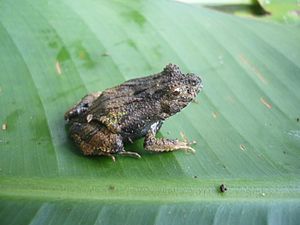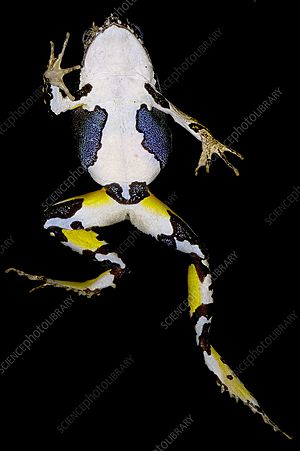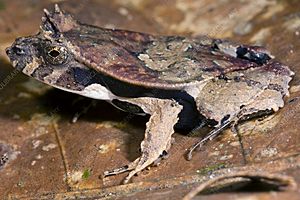Perez's snouted frog facts for kids
Quick facts for kids Perez's snouted frog |
|
|---|---|
 |
|
| Conservation status | |
| Scientific classification | |
| Synonyms | |
|
Bubonias plicifrons Cope, 1874 |
The Edalorhina perezi is also known as the Perez's snouted frog. This frog is part of the Leptodactylidae family. It is one of only two species in its group, called the Edalorhina genus.
Perez's snouted frogs are active during the day and live on land. When it's time to mate, both male and female frogs gather around puddles found near fallen trees. You can find these frogs in Brazil, Colombia, Ecuador, and Peru. They might also live in Bolivia.
Their natural homes are warm, wet forests in lowlands or mountains, and freshwater marshes. The good news is that the number of these frogs is stable. They are listed as "least concern" by the IUCN Red List, which means they are not currently in danger.
Contents
What Does the Perez's Snouted Frog Look Like?
Adult Frogs
Just like many other frog species, female Perez's snouted frogs are bigger than males. Males usually measure about 28-36 mm (about 1.1 to 1.4 inches). Females are a bit larger, at 35-40 mm (about 1.4 to 1.6 inches).
These frogs are often the same color as the dead leaves on the forest floor. This helps them hide from predators and prey. Their back is brown, often with dark brown spots or bumps. A special feature of this frog is the small, cone-shaped bumps around its eyelids. They also have a ridge between their eyes. Their eyes have a bronze color with grayish-brown lines.
The frog's body has a slightly curved shape, with its spine dipping down. This helps tell it apart from its closest relatives. The underside of the frog is smooth and white, with large black dots on the sides and back. Their legs have stripes. As land-dwelling frogs, their toes are not webbed. The first and second toes are the same length.
The Perez's snouted frog has a pointed snout. Its close relative, E. nasuta, has an even sharper snout because of a long, fleshy nose-like part. E. nasuta also has smaller bumps on its eyelids. Another similar frog, "Physalaemus Petersi," does not have eyelid bumps. It also has a different black and white belly pattern and a gray throat and chest.
Baby Frogs (Tadpoles)
Baby Perez's snouted frogs, called tadpoles, look similar to other tadpoles in their group. However, they have a unique mouth shape at the end of their body. They also have a special tube on their right side for getting rid of waste.
These tadpoles are usually between 14 mm and 29.7 mm long from head to tail. Their body is about 5 mm long and is wider than it is deep. They have small eyes that are far apart on the front sides of their head. The tadpoles are generally pale brown with darker brown streaks on their back and sides.
Where Do Perez's Snouted Frogs Live?
Perez's snouted frogs are often found in the upper Amazon Basin. This includes parts of Ecuador and Peru. Some groups of these frogs also live in southern Colombia and Brazil. They can be found in areas from 200 meters (about 650 feet) high up to 1100 meters (about 3,600 feet) on the eastern slopes of the Andes Mountains.
These frogs are active during the day and live on the ground. They prefer the floors of tropical rainforests that are covered with leaf litter. They can live well in both untouched forests and forests that have been regrown.
What Do Perez's Snouted Frogs Eat?
Perez's snouted frogs are "sit-and-wait" hunters. This means they hide using their camouflage colors and wait for prey to come by. They eat insects and other small creatures that move around in the leaf litter. These include cockroaches, spiders, and crickets. Scientists think these frogs only eat a few times a day.
Tadpoles mainly eat tiny bits of dead plants and animals found at the bottom of their pools. However, there have been times when tadpoles were seen eating eggs or other tadpoles.
Reproduction and Life Cycle
Mating Habits
Perez's snouted frogs breed when they have the chance, usually right after a storm. During mating, the female frog carries the male to the edge of a puddle. There, they work together to build a foam nest. Water is very important for building the nest, so the female always drinks water before mating.
The female is drawn to the male's special mating call. She moves towards him when he calls. During mating season, these frogs are active both day and night. The mating process can last up to six days, but the actual egg-laying only takes about four to six hours.
First, the female arches her back to signal that it's time to build the foam nest. The male then quickly puts his feet near the female's rear end, forming a "collecting basket." This is where the eggs are fertilized. After this, the male lifts his legs to the water level and starts beating the female's foamy liquid. This helps to smooth the surface of the nest. This beating lasts about 10-12 seconds, with around 45 beats. After about 45 seconds, the female gives the back-arching signal again, and the whole process repeats. Building a foam nest usually takes 30 to 60 minutes.
Frog Calls
Male Perez's snouted frogs make different sounds. A common sound, called an "advertisement call," can be heard from far away. It sounds like a series of three to five short, low whistles. Each whistle has two quick pulses. There is also another call they make before mating. This call has double pulses and repeats at a steady rate.
Male frogs choose calling spots that are a bit different from where females choose to lay eggs. This is because they have different needs. Both males and females try to avoid pools where predators might eat their babies. However, males are less worried about the risks their babies might face. When choosing a spot, male frogs focus more on avoiding predators and finding females. Females think more about their babies' survival. So, males might choose a spot that is not great for babies but has fewer predators and less competition for mates.
Parental Care
Female Perez's snouted frogs can lay eggs every four weeks in a controlled environment. They lay between 30 and 154 small, uncolored eggs. These eggs are about 2.1 mm wide and are laid in a foam nest about 60 mm across. The foam nest helps protect the eggs and young tadpoles. If conditions are perfect, the foam can protect tadpoles in dry pools for up to 13 days. About half of them can survive for up to 10 days. However, tadpoles need at least two weeks in water to fully grow. This means that in a tropical forest, where temperatures are steady but rainfall changes with the seasons, the amount of rain strongly affects how many babies survive.
Perez's snouted frogs like to lay their eggs in "treefall pools." These are holes at the roots of large fallen trees. These pools can be temporary or permanent. Many other tree frogs and poison-dart frogs also use these holes for nesting.
A study showed that female Perez's snouted frogs are very smart about where they lay their eggs. The three main dangers for their babies are drying out, being eaten by insects, and competition from other tadpoles. For drying out and insect predators, there's a trade-off. Temporary pools have fewer insect predators, but they can dry up completely.
Experiments showed that adult frogs actively choose pools that are best for their babies based on these three factors. Their choices are flexible and change with time and place. They don't just follow seasonal changes. In the early rainy season, females usually choose pools that stay wet longer. But later in the season, they switch to temporary pools. This happens because rainfall is uncertain early on, so stable pools are safer. Later in the season, rain is more consistent. The permanent pools then have more insect predators and more tadpoles, making temporary pools better with less risk and competition for food. The male's calling spot does not affect where the female chooses to lay her eggs. After mating, the female can carry the male to her preferred egg-laying spot.
Hatching and Tadpole Development
Tadpoles begin to hatch from their eggs three to five days after the foam nest is built, if the temperature is around 26°C (79°F). The newly hatched tadpoles are white and cannot move much. They still have yolk in their stomachs for food. They also don't have external gills or sticky organs yet. They stay at the bottom of the nest for one day. The next day, they start to feed. Their color changes from white to a camouflaged brownish color during the third week. The young froglets leave the water during the fourth week after hatching.
Once the tadpoles enter the water, many predators can eat them. These include insects like damselflies, dragonflies, and predatory beetles. Even some animals with backbones, like the turtle Platemys platicephala, can prey on Perez's snouted frog tadpoles. The time it takes for a tadpole to grow and change into a froglet can vary a lot. It can take anywhere from 21 to 28 days. Many things can affect this, such as how fast the pool dries, its depth, temperature, how much food is available, and how many predators and other tadpoles are in the pool.
How Do Perez's Snouted Frogs Protect Themselves?
Tadpoles start to develop their camouflaged brown colors three weeks after hatching. These colors stay with them into adulthood. An interesting way the Perez's snouted frog defends itself is by using a "scare display." They do this with special glands called macroglands, found near their lower back.
When a Perez's snouted frog gets scared, it will turn away from the predator. Then, it suddenly lifts its lower back to show these macroglands. These glands have hidden bright colors that look like a pair of huge eyes belonging to a much larger animal. This can scare away predators!
Images for kids







